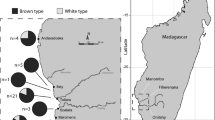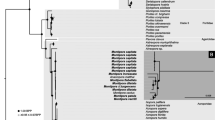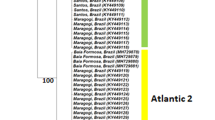Abstract
Studies on the biodiversity and evolution of octocorals are hindered by the incomplete knowledge of their taxonomy, which is due to few reliable morphological characters. Therefore, assessment of true species diversity within abundant and ecologically important families such as Xeniidae is difficult. Mitochondrial genes provide a reliable solution to this problem for a wide range of taxa. However, low mutation rates of the mitochondrial DNA in octocorals result in insufficient variability for species discrimination. We compared the variation of a fragment of the Signal Recognition Particle 54 gene (SRP54, proposed for octocorals) and the mitochondrial ND6/ND3 marker among members of the xeniid genera Ovabunda, Xenia, Heteroxenia and Bayerxenia. The mean uncorrected pairwise sequence divergence was 39 % for SRP54 compared to 2 % for ND6/ND3. Morphological assignments were not always supported by genetics: Species diversity was underestimated (one case) or overestimated, probably reflecting intraspecific polymorphisms or hinting at recent speciations. ND6/ND3 is informative for some species-level assignments, whereas SRP54 shows the variability needed for species delimitations within this understudied taxon. Our results on both genes show their potential for evolutionary and biodiversity studies in Xeniidae.



Similar content being viewed by others
References
Achituv, Y., & Benayahu, Y. (1990). Polyp dimorphism and functional, sequential hermaphroditism in the soft coral Heteroxenia fuscescens (Octocorallia). Marine Ecology Progress Series, 64, 263–269.
Affeld, S., Kehraus, S., Waegele, H., & Koenig, G. (2009). Dietary derived sesquiterpenes from Phyllodesmium lizardensis Burghardt, Schrödl & Wägele (Opisthobranchia, Nudibranchia, Aeolidoidea). Journal of Natural Products, 72, 298–300.
Aguilar, C., & Sanchez, J. A. (2007). Phylogenetic hypotheses of gorgoniid octocorals according to ITS2 and their predicted RNA secondary structures. Molecular Phylogenetics and Evolution, 43, 774–786.
Aharonovich, D., & Benayahu, Y. (2011). Microstructure of octocoral sclerites for diagnosis of taxonomic features. Marine Biodiversity. doi:10.1007/s12526-011-0102-3.
Alderslade, P. (2001). Six new genera and six new species of soft coral, and some proposed familial and subfamilial changes within the Alcyonacea (Coelenterata, Octocorallia). Bulletin of the Biological Society of Washington, 10, 15–65.
Anta, C., González, N., Santafé, G., Rodríguez, J., & Jiménez, C. (2002). New Xenia diterpenoids from the Indonesian soft coral Xenia sp. Journal of Natural Products, 65, 766–768.
Baco, A. R., & Cairns, S. D. (2012). Comparing molecular variation to morphological species designations in the deep-sea coral Narella reveals new insights into seamount coral ranges. PLoS One, 7(9), e45555. doi:10.1371/journal.pone.0045555.
Benayahu, Y. (1990). Xeniidae (Cniadaria: Octocorallia) from the Red Sea, with the description of a new species. Zoologische Medelingen Leiden, 64, 113–120.
Berntson, E. A., Bayer, F. M., McArthur, A. G., & France, S. C. (2001). Phylogenetic relationships within the Octocorallia (Cnidaria: Anthozoa) based on nuclear 18S rRNA sequences. Marine Biology, 138, 235–246.
Burghardt, I., & Waegele, H. (2004). A new solar powered species of the genus Phyllodesmium Ehrenberg, 1831 (Mollusca: Nudibranchia: Aeolidoidea) from Indonesia with analysis of its photosynthetic activity and notes on biology. Zootaxa, 596, 1–18.
Burghardt, I., Stemmer, K., & Waegele, H. (2008). Symbiosis between Symbiodinium (Dinophyceae) and different taxa of Nudibranchia (Mollusca: Gastropoda) with analyses of longterm retention. Organisms, Diversity and Evolution, 8, 66–76.
Burghardt, I., Schroedl, M., & Waegele, H. (2008). Three new solar-powered species of the genus Phyllodesmium Ehrenberg, 1831 (Mollusca:Nudibranchia:Aeolidioidea) from the tropical Indo-Pacific, with analysis of their photosynthetic activity and notes on biology. Journal of Molluscan Studies, 74, 277–292.
Chen, I. P., Tang, C. Y., Chiou, C. Y., Hsu, J. H., Wei, N. V., Wallace, C. C., et al. (2008). Comparative analyses of coding and noncoding DNA regions indicate that Acropora (Anthozoa: Scleractinia) possesses a similar evolutionary tempo of nuclear vs. mitochondrial genomes as in plants. Marine Biotechnology, 11, 141–152.
Concepcion, G. T., Crepeau, M. W., Wagner, D., Kahng, S. E., & Toonen, R. J. (2008). An alternative to ITS, a hypervariable, single-copy nuclear intron in corals, and its use in detecting cryptic species within the octocoral genus Carijoa. Coral Reefs, 27, 323–336.
Dorado, D., & Sanchez, J. A. (2009). Internal Transcribed Spacer 2 (ITS2) variation in the Gorgonian Coral Pseudopterogorgia bipinnata in Belize and Panama. Smithsonian Contributions to the Marine Sciences, 38, 173–179.
Drummond, A. J., Ashton, B., Buxton, S., Cheung, M., Cooper, A., Duran, C., et al. (2012). Geneious v5.6. http://www.geneious.com.
Ehrenberg, G. G. (1831). Symbolae Physicae seu icones est descriptiones animalium evertebratorum sepositis insectis quae ex itinere per Agricam Borealem et Asiam Occidentalem. Decas 1 Moll.
Ehrenberg, C. G. (1834). Beiträge zur Kenntnis der Corallenthiere im allgemeinen, und besonderen des Rothen Meeres, nebst einem Versuche zur physiologischen Systematik derselben. Abhandlungen der Königlichen Akademie der Wissenschaft Berlin (1832), 1, 225–380.
Flot, J.-F., Blanchot, J., Charpy, L., Cruaud, C., Licuanan, W. Y., Nakano, Y., et al. (2011). Incongruence between morphotypes and genetically delimited species in the coral genus Stylophora: phenotypic plasticity, morphological convergence, morphological stasis or interspecific hybridization? BMC Ecology, 11, 22.
Forsmann, Z. H., Concepcion, G. T., Haverkort, R. D., Shaw, R. W., Maragos, J. E., & Toonen, R. J. (2010). Ecomorph or endangered coral? DNA and microstructure reveal Hawaiian species complexes: Montipora dilatata/ flabellata/turgescens & M. patula/verrilli. Plos One, 5, 12.
France, S., & Hoover, L. (2001). Analysis of variation in mitochondrial DNA sequences (ND3, ND4L, MSH) among Octocorallia (Alcyonaria) (Cnidaria: Anthozoa). Bulletin of the Biological Society of Washington, 10, 110–118.
France, S., & Hoover, L. (2002). DNA sequences of the mitochondrial COI gene have low levels of divergence among deep-sea octocorals (Cnidaria: Anthozoa). Hydrobiologia, 471, 1–3.
Fukami, H., Budd, H. F., Levitan, D. R., Jara, J., Kersanach, R., & Knowlton, N. (2004). Geographic differences in species boundaries among members of the Montastraea annularis complex based on molecular and morphological markers. Evolution, 58, 324–337.
Gohar, H. A. F. (1940). Studies on the Xeniidae of the Red Sea. Their ecology, physiology, taxonomy and phylogeny. Publications of the Marine Biological Station, Al Ghardaqa, Egypt, 2, 25–118.
Hatta, M., Fukami, H., Wang, W., Omori, M., Schimoike, K., Hayashibara, T., et al. (1999). Reproductive and genetic evidence for a reticulate evolutionary history of mass-spawning corals. Molecular Biology and Evolution, 16, 1607–1613.
Hebert, P. D. N., Cywinska, A., Ball, S. L., & deWaard, J. R. (2003). Biological identifications through DNA barcodes. Proceedings of the Royal Society of London B, 270, 313–321.
Hebert, P. D. N., Ratnasingham, S., & de Waard, J. R. (2003). Barcoding animal life: cytochrom C oxidase subunit 1 divergences among closely related species. Proceedings of the Royal Society of London B, 270, 596–599.
Hebert, P. D. N., Stoeckle, M. Y., Zemlak, T. S., & Francis, C. M. (2004). Identification of birds through DNA barcodes. PLoS Biology. doi:10.1371/journal.pbio.0020312.
Hellberg, M. E. (2006). No variation and low synonymous substitution rates in coral mtDNA despite high nuclear variation. BMC Evolutionary Biology, 6, 24.
Huang, D., Meier, R., Todd, P. A., & Ming Chou, L. (2008). Slow mitochondrial COI sequence evolution at the base of the metazoan tree and its implications for DNA barcoding. Journal of Molecular Evolution, 66, 167–174.
Huelsenbeck, J. P. (2001). MrBayes: A program for the Bayesian inference of phylogeny. Manual.
Huelsken, T., Waegele, H., Peters, B., Mather, A., & Hollmann, M. (2011). Molecular analysis of adults and egg masses reveals two independent lineages within the infaunal gastropod Naticarius onca (Röding, 1798) (Caenogastropoda: Naticidae). Molluscan Research, 3, 141–151.
Katho, K., Misawa, K., Kuma, K., & Miyata, T. (2002). Mafft: a novel method for rapid multiple alignment based on fast Furier transform. Nucleic Acids Research, 30, 3059–3066.
Koelliker, A. (1874). Die Pennatulidae Umbellula und zwei neue Typen der Alcyonarien. Festschrift zur Feier des 25-jährigen Bestehens der Physikalisch-Medizinischen Gesellschaft 5–23.
Lamarck, J. B. P. A. (1816). Polypes tubiferes. In Histoire naturelle des animeaux sans vertebres. IV + 568 pp. Paris, Verdiere
McFadden, C. S., & Hutchinson, M. B. (2004). Molecular evidence for the hybrid origin of species in the soft coral genus Alcyonium (Cnidaria: Anthozoa: Octocorallia). Molecular Ecology, 13, 1495–1505.
McFadden, C. S., Donahue, R., Hadland, B. K., & Weston, R. (2001). A molecular phylogenetic analysis of reproductive trait evolution in the soft coral genus Alcyonium. Evolution, 55, 54–67.
McFadden, C. S., Tullis, I. D., Hutchinson, M. B., Winner, K., & Sohm, J. A. (2004). Variation in coding (NADH Dehydrogenase Subunits 2, 3 and 6) and noncoding intergenetic spacer regions of the mitochondrial genome in Octocorallia (Cnidaria: Anthozoa). Marine Biotechnology, 6, 516–526.
McFadden, C. S., France, S. C., Sánchez, J. A., & Alderslade, P. (2006). A molecular phylogenetic analysis of the Octocorallia (Cnidaria: Anthozoa) based on mitochondrial protein-coding sequences. Molecular Phylogenetics and Evolution, 41, 513–527.
McFadden, C. S., Sanchez, J., & France, S. (2010a). Molecular phylogenetic insights into the evolution of Octocorallia: a review. Integr Comp Biol, 1–22.
McFadden, C. S., Benayahu, Y., Pante, E., Thoma, J. N., Nevarez, A., & France, S. (2010). Limitations of mitochondrial gene barcoding in Octocorallia. Molecular Ecology Resources. doi:10.1111/j.1755-0998.2010.02875.x.
Park, E., Hwang, D. S., Lee, J. S., Song, J. I., Seo, T. K., & Won, Y. J. (2012). Estimation of divergence times in cnidarian evolution based on mitochondrial protein-coding genes and the fossil record. Molecular Phylogenetics and Evolution, 62, 329–345.
Pillay, K. R. M., Asahida, T., Chen, C. A., Terashima, H., & Ida, H. (2006). ITS ribosomal DNA distinctions and the genetic structures of populations of two sympatric species of Pavona (Cnidaria; Scleractinia) from Mauritius. Zoological Studies, 45, 132–144.
Posada, D. (2008). jModelTest: phylogenetic model averaging. Molecular Biology and Evolution, 25, 1253–1256.
Reinicke, G. B. (1995). Xeniidae des Roten Meeres (Octocorallia, Alcyonacea)—Beiträge zur Systematik und Ökologie. Essener Ökologische Schriften, 6, 1–168.
Reinicke, G. B. (1997). Xeniidae (Coelenterata, Octocorallia) of the Red Sea, with descriptions of six new species of Xenia. Fauna of Saudi Arabia, 16, 5–62.
Roxas, H. A. (1933). The Philippine Alcyonaria. The families Cornulariidae and Xeniidae. Philippine Journal of Science, 50, 49–110.
Shearer, T. L., & Coffroth, M. A. (2008). Barcoding corals: limited by interspecific divergence, not intraspecific variation. Molecular Ecology Resources, 8, 247–255.
Shearer, T. L., vanOppen, M. J. H., Romano, S. L., & Woerheide, G. (2002). Slow mitochondrial DNA sequence evolution in the Anthozoa (Cnidaria). Molecular Ecology, 11, 2475–2487.
Stamatakis, A. (2006). RAxML-VI-HPC: maximum likelihood-based phylogenetic analyses with thousands of taxa and mixed models. Bioinformatics, 22, 2688–2690.
Strychar, K. B., Coates, M., Sammarco, P. W., Piva, T. J., & Scott, P. T. (2005). Loss of Symbiodinium from bleached soft corals Sarcophyton ehrenbergi, Sinularia sp. and Xenia sp. Journal of Experimental Marine Biology and Ecology, 320, 159–177.
Van Oppen, M. J. H., Willis, B. L., Van Vugt, H., & Miller, D. J. (2000). Examination of species boundaries in the Acropora cervicornis group (Scleractinia, Cnidaria) using nuclear DNA sequence analyses. Molecular Ecology, 9, 1363–1373.
Van Oppen, M. J. H., McDonald, B. J., Willis, B., & Miller, D. J. (2001). The evolutionary history of the coral genus Acropora (Scleractinia, Cnidaria) based on a mitochondrial and a nuclear marker: reticulation, incomplete lineage sorting, or morphological convergence? Molecular Biology and Evolution, 18, 1315–1329.
Van Oppen, M. J. H., Willis, B. L., Van Rheede, T., & Miller, D. J. (2002). Spawning times, reproductive compatibilities and genetic structuring in the Acropora aspera group: evidence for natural hybridization and semi-permeable species boundaries in corals. Molecular Ecology, 11, 1363–1376.
Van Oppen, M. J. H., Koolmees, E. M., & Veron, J. E. N. (2004). Patterns of evolution in the scleractinian coral genus Montipora (Acroporidae). Marine Biology, 144, 9–18.
Verseveldt, J., & Cohen, J. (1971). Some new species of Octocorallia from the Gulf of Elat (Red Sea). Israel Journal of Zoology, 20, 53–67.
Vollmer, S. V., & Palumbi, S. R. (2004). Testing the utility of internally transcribed spacer sequences in coral phylogenetics. Molecular Ecology, 13, 2763–2772.
Waegele, H., Raupach, M. J., Haendeler, K., & Burghardt, I. (2010). Solar powered seaslugs: Incorporation of photosynthetic units—a key character enhancing radiation? In M. Glaubrecht & H. Schneider (Eds.), Evolution in action—adaptive radiations and the origins of biodiversity (pp. 263–282). Berlin: Springer.
Ward, R. D., Zemlak, T. S., Innes, B. H., Last, P. R., & Hebert, P. D. N. (2005). DNA barcoding Australia’s fish species. Philosophical Transactions of the Royal Society B, 360, 1847–1857.
Wei, N. V., Wallace, C. C., Dai, C. F., Pillay, K. R. M., & Chen, C. A. (2006). Analyses of the ribosomal internal transcribed spacers (ITS) and the 5.8S gene indicate that extremely high rDNA heterogeneity is a unique feature in the scleractinian coral genus Acropora (Scleractinia; Acroporidae). Zoological Studies, 45, 404–418.
Acknowledgments
We would like to thank our diving and collecting companions on Lizard Island (Australia), from Dimakya Island (Philippines), Dahab (Egypt) and Bali (Indonesia): Sebastian Striewski (Bochum), Christoph Haake (Munich), Sabrina Bleidissel (Wuppertal) and Martina Vogt (Cologne). We thank Kathrin P. Lampert for her support with any questions we had. Special thanks to the Lizard Island Research Station (LIRS) for their permanent support. Furthermore, we would like to thank our laboratory staff: Malgorzata Rudschewski, Beate Hackethal, Claudia Brefeld and Gabi Strieso (Ruhr University). The German Science Foundation supported the collecting trips to Lizard Island (Australia) for KS and HW (Wa 618/8).
Authors’ contributions
KS, FL, IB, HW and RT designed the study. KS and FL did the laboratory work. KS, FL and CM performed the computer analyses. IB and GR helped with the morphological investigations. KS, FL, CM and HW drafted the manuscript and interpreted the data. RT and GR made valuable contributions to the interpretation of the data. All authors have read and approved the final version of the manuscript.
Author information
Authors and Affiliations
Corresponding author
Additional information
Kristina Stemmer and Florian Leese contributed equally to this study.
Electronic supplementary material
Below is the link to the electronic supplementary material.
ESM 1
(PDF 4437 kb)
Rights and permissions
About this article
Cite this article
Stemmer, K., Burghardt, I., Mayer, C. et al. Morphological and genetic analyses of xeniid soft coral diversity (Octocorallia; Alcyonacea). Org Divers Evol 13, 135–150 (2013). https://doi.org/10.1007/s13127-012-0119-x
Received:
Accepted:
Published:
Issue Date:
DOI: https://doi.org/10.1007/s13127-012-0119-x




